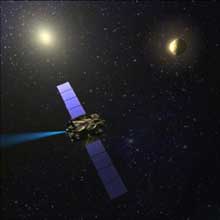ESA develops a smarter way to travel through space

ESA are helping to develop a new type of rocket engine;; known as solar-electric propulsion;; or more commonly;; an ion engine;; that can open the door to a whole new era of space exploration. photo: ESA
As scientists demand more from space missions travelling to other worlds and beyond, traditional rocket technologies are beginning to show shortcomings. In response, ESA are helping to develop a new type of rocket engine, known as solar-electric propulsion, or more commonly, an ion engine, that can mark a whole new era of space exploration.
Solar-electric propulsion is ESA`s new spacecraft engine. It does not burn fuel as chemical rockets do; instead the technique converts sunlight into electricity via solar panels and uses it to electrically charge heavy gas atoms, which accelerate from the spacecraft at high velocity. This drives the spacecraft forwards. In a chemical rocket, burning the fuel creates gas that is expelled relatively slowly compared to electric thrusters. However, in an ion engine, the gas is ejected at large velocities, which makes it generally much more efficient, so less fuel is required.
Such engines have long been the subject of science fiction; now ESA has helped turn them into science fact. A small ion engine is currently lifting ESA`s telecommunications satellite, Artemis, to its planned orbit around Earth and, early in 2003, SMART-1 will blast off from Kourou, French Guiana. Once in space, this small craft will use an ion engine to reach the Moon.
Ion engines are truly important because their high efficiency makes previously impossible missions achievable. In fact, SMART-1 will test a manoeuvring technique, using its ion engine and the gravitational pull of the Moon, which will be essential for ESA`s BepiColombo mission to Mercury, lifting off in 2012. Giuseppe Racca, project manager for SMART-1, explains, “With chemical propulsion you can only do a fly-by or go into a very elongated orbit around the planet. If you want to achieve a low Mercury orbit and really observe the planet, then you can only do that with electric propulsion.”
As well as BepiColombo, solar-electric propulsion will be used for ESA`s Solar Orbiter mission, to be launched at the same time. This probe will use an ion engine to rise out of the plane of the Solar System and study the Sun at high latitudes.
Since they do not need to carry so much fuel, ion engines release room for more scientific instruments. As technology continues to get smaller, the size of instruments decreases and the overall size and mass of the spacecraft decreases, further increasing efficiency. Racca says, “Solar-electric propulsion opens up the way to explore the inner part of the Solar System because you have the Sun to power you.”
Further away, however, where the Sun`s light is weaker, a new electricity source, such as a nuclear generator, would be needed. This is the next logical step for the technology, according to Racca. He says, “They could take us to the Kuiper belt and even farther away.” The Kuiper belt extends beyond the planet Pluto and is a dream destination for many scientists because it contains comets that have been undisturbed since the formation of the Solar System. Beyond these comets is a mysterious realm of magnetic fields and rarefied gases known as interstellar space that astronomers would love to explore. Solar-electric propulsion would make such a mission possible because an ion engine can run almost constantly, so that eventually it outperforms any chemical rocket on such long flights.
“Electric propulsion as a whole, including solar and nuclear types, will really allow us to open a new era of Solar System exploration,” concludes Racca.
Media Contact
More Information:
http://sci.esa.int/All latest news from the category: Physics and Astronomy
This area deals with the fundamental laws and building blocks of nature and how they interact, the properties and the behavior of matter, and research into space and time and their structures.
innovations-report provides in-depth reports and articles on subjects such as astrophysics, laser technologies, nuclear, quantum, particle and solid-state physics, nanotechnologies, planetary research and findings (Mars, Venus) and developments related to the Hubble Telescope.
Newest articles

A blueprint for mapping melting ice sheets
Researchers in the Stanford Radio Glaciology lab use radio waves to understand rapidly changing ice sheets and their contributions to global sea-level rise. This technique has revealed groundwater beneath Greenland,…

Water hyacinth plant pots – utilization of an invasive species
Together with Fiber Engineering GmbH, the DITF presents a process for the production of biodegradable plant pots. The products are cost effective and competitive. At the same time, the production…

Current research on the new 6G mobile communications standard
Nursing care robots, autonomous driving, digital twins: all of these high-tech applications will play an essential role for the new 6G mobile communications standard. The first commercial 6G networks are…



